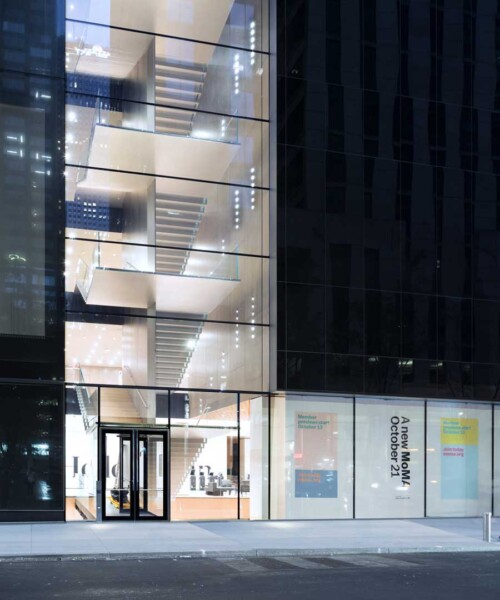Monday, October 21, The Museum of Modern Art (MoMA) will finally unveil its multi-year expansion project, masterminded by New York-based architecture firm Diller Scofidio + Renfro (the team behind The Shed at Hudson Yards, The Broad, The High Line and Lincoln Center) in collaboration with design studio Gensler (who created the interiors for The New York Times, L’Oreal and 20th Century Fox’s New York headquarters). The new expanded footprint will add much needed square footage to the institution while improving the flow of the spaces and offering fresh perspectives on works old and new. The last major addition by Yoshio Taniguchi in 2004 enhanced the public spaces of the museum while maintaining the minimalist, modernist roots of Philip Goodwin and Edward Durell Stone’s original 1939 building and Philip Johnson’s 1964 addition but more change was needed. “This work has required the curiosity of an archeologist and the skill of a surgeon,” said Elizabeth Diller, founding partner of Diller Scofidio + Renfro. “The improvements will make the visitor experience more intuitive and relieve congestion, while a new circulation network will knit together the expansion spaces with the lobbies, the theaters, and the Sculpture Garden to create a contiguous, free public realm that bridges street to street and art to city.”

MoMA (photography by Iwan Baan)
Since 2016, the museum has been under construction and, for the past five months, it has been closed to the public while it connects the old and new footprints. Gallery spaces have been expanded by 30 percent (including the debut of the new David Geffen Wing with over 30,000 square feet), the free-to-the-public lobby enlarged, cafes and lounges added, facilities renovated and technology updated within the new plan (which now totals 175,000 square feet). Improving the circulation and offering new ways to showcase the museum’s amazing collection of 20th century art, video, photography, architecture, and design was a mandate.

MoMA (photography by Iwan Baan)
“Our curators and the architectural team have spent more than two years in conversations about the nature of our collection, the history of our installations, the continually changing nature of art and our opportunities and responsibilities for engaging our audiences,” MoMA’s director Glenn D. Lowry said. “The outcome of these discussions is a design that accommodates a global view and new perspectives on modern and contemporary art, and that embodies the metabolic and self-renewing nature of our institution.” Seamlessly blending the old and the new spaces while making the museum feel more open to the public and the area surrounding the structures was also paramount to a successful reimagining after 90 years in business. “This project has called on us to work across MoMA’s rich architectural history, incorporating the Museum’s existing building blocks into a comprehensible whole through careful and deliberate interventions into previous logics, as well as the construction of new logics that arise from MoMA’s current aspirations,” said Diller.

MoMA (photography by Iwan Baan)
When it reopens, the inaugural exhibitions will highlight the museum’s permanent collection and exciting recent gifts. These shows include “Sur moderno: Journeys of Abstraction―The Patricia Phelps de Cisneros Gift” with a focus on the museum’s impressive collection of modern Latin American art through paintings, sculptures and works on paper donated by the Colección Patricia Phelps de Cisneros between 1997 and 2016. “Betye Saar: The Legends of Black Girls Window” features Saar’s autobiographical sculpture Black Girl’s Window (1969) in contrast with the artist’s rarely-seen, early prints from the 1960s. “The way we are looking at it is that, rather than thinking of this display—which sprawls across almost 170,000 square feet and consists of almost 2,500 works of art—as somehow permanent or even quasi-permanent, we think of it as a point in time that over a two-to-three-year period will virtually entirely change again,” Lowry told Artnet News. “Critical works that people travel long distances to see, like Matisse’s Dance, Van Gogh’s Starry Night, the Demoiselles d’Avignon, Monet’s Water Lilies—we’re not going to change those. But we might change where they’re located, and we certainly will change their neighbors.”







































